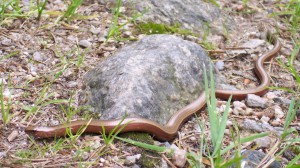Slow worm
 The slow worm, or blindworm, has a long fusoid body. The young species are spectacular silvery-white or cream-white on top, with two thin and close dark lines along the spine. Their sides and bellies are black-brown or almost black, with the striking difference between the lighter back and the darker lateral coloration. This lizard can be 60 cm long, with over half of the length being a very fragile tail slightly pointed at the tip. They are fairly abundant in the area. They inhabit broadleaved and mixed forests, and can also be encountered in shrubs, meadows, fields and gardens – given the vicinity of the forest usually. It is really slow moving across a flat spot; however it becomes rather deft making its way through vegetation or between rocks, wriggling its body like a snake. It is mainly active in twilight and at nights, rarely emerging from its shelter during days – usually when the sky is overcast but the air is warm, or following a night shower. Slow worms prey on earthworms, terrestrial mollusks, insect larvae, centipedes and other slow-moving animals, since they cannot pursue a faster prey. 2.5-3 months following spring mating, the female delivers 5 to 26 young in transparent shells, which they immediately break through and crawl away. The length of young lizards when born does not usually exceed 100 mm with the tail. Slow worms winter in rodent holes and recesses of rotten stumps, sometimes gathering up to 20-30 species together. Due to their sloth and utmost vulnerability, these lizards often fall prey to various enemies, which they manage to escape from only making use of their long tail they shed when predators get hold of it with their fangs or claws. In many areas slow worms are mistaken for poisonous snakes and are relentlessly exterminated. In reality, the slow worm is absolutely harmless and rather useful to mankind, since it exterminates a number of pests.
The slow worm, or blindworm, has a long fusoid body. The young species are spectacular silvery-white or cream-white on top, with two thin and close dark lines along the spine. Their sides and bellies are black-brown or almost black, with the striking difference between the lighter back and the darker lateral coloration. This lizard can be 60 cm long, with over half of the length being a very fragile tail slightly pointed at the tip. They are fairly abundant in the area. They inhabit broadleaved and mixed forests, and can also be encountered in shrubs, meadows, fields and gardens – given the vicinity of the forest usually. It is really slow moving across a flat spot; however it becomes rather deft making its way through vegetation or between rocks, wriggling its body like a snake. It is mainly active in twilight and at nights, rarely emerging from its shelter during days – usually when the sky is overcast but the air is warm, or following a night shower. Slow worms prey on earthworms, terrestrial mollusks, insect larvae, centipedes and other slow-moving animals, since they cannot pursue a faster prey. 2.5-3 months following spring mating, the female delivers 5 to 26 young in transparent shells, which they immediately break through and crawl away. The length of young lizards when born does not usually exceed 100 mm with the tail. Slow worms winter in rodent holes and recesses of rotten stumps, sometimes gathering up to 20-30 species together. Due to their sloth and utmost vulnerability, these lizards often fall prey to various enemies, which they manage to escape from only making use of their long tail they shed when predators get hold of it with their fangs or claws. In many areas slow worms are mistaken for poisonous snakes and are relentlessly exterminated. In reality, the slow worm is absolutely harmless and rather useful to mankind, since it exterminates a number of pests.
/ * The photos at lake.peipsi.org are cross-posted from commons.wikimedia.org and are used for familiarization purposes only. No commercial use of the photos is allowed. For more information about to use the photos see the originals on commons.wikimedia.org. /


